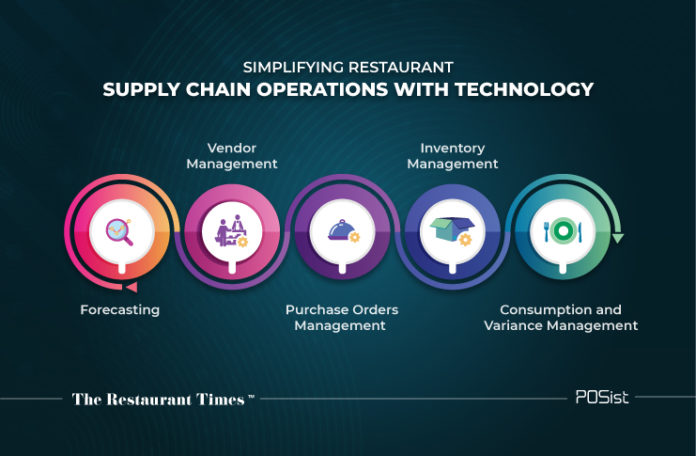The 5 basic supply chain components in restaurant industry
1. Demand sensing / Forecasting: The restaurant supply chain loop starts with a thorough understanding of market forecasting. This gives the restaurant a holistic approach of adapting its offerings and menu according to consumer demand.
2. Sales management: It is important to find the best vendors in the
restaurant industry to preserve consistency and productivity. It's also essential
to use on-board technologies that helps handle vendors according to quality and performance.
3.Purchase order management: The replenishment of orders differs even
among restaurant chains with several locations, depending on various customer preferences.
One outlet may require a different raw material from the other, or the volumes can
vary.
4. Inventory management: When there is a 'loss of stock' problem, a big source of customer discontent is. Restaurants hold a adequate quantity of all the products or raw materials needed for food production to prevent mismanagement. Effective running of the supply chain means zero waste / failure.
5. Demand and Variation Management: It is important for a restaurant to consider how much inventory is needed for preparing meals, and what the real consumption is. The variation contrasts the real stock (current counted inventory) to the ideal demand (stock value to be present). Consumption control is important to consider whether the employees at the restaurant are following a set of food quality guidelines.

How Is Technology Solving The Supply Chain Complexities For The Restaurant Industry – Common Problems & Solutions
Technology leads to greater communication across the whole supply chain,
allowing a deeper view of the processes. In a single forum, it binds all related
parties participating in the process. All necessary information of the whole order
period can be given with only a single press.
Forecasting
Projection or demand sensing is a crucial step in the overall cycle of supply chain activities in restaurants.
Let's take the example of a food chain where Product X has achieved
the highest revenue, to grasp this. Product Y was the least-selling item over the
menu, however.Product Y did not do well in the industry, amid marketing efforts.
Good X sales have declined owing to a lack in production due to business conditions.
As a result the restaurant's net profits were affected.
This resulted in stock wastage which resulted in higher losses leading to cost-cutting across multiple operations, eventually impacting vendor relationships.
Simplifying Forecasting With Technology – Automated
Forecasting Via Restaurant POS
An automatic forecasting platform offers prediction of the projected
volume of revenue based on consumer demand trends. It's convenient to predict inventory
needs based on the in-hand physical stock in the kitchen and the item-wise selling
from each outlet. Demand sensor systems produce predictions for menu items as well
as for raw material products. Restaurateurs can build exclusive deals for any channel
on the menu items. Often, a proportionate inventory forecast excludes the problems
relevant to raw material ageing.
Vendor management
Vendor management is essential to the extent and complexity of a restaurant
operation.If you're a fine-dine, a QSR line, or a business-grade operation, combining
vendor-partners and monitoring them through technologies is important.
Bad vendor management can lead to:
• Lack of the raw materials provided to a restaurant by the suppliers
• The consistency of the products is degraded due to inadequate storage conditions
• Distribution problem or delay in fulfilment of orders in due time
• High operating costs resulting from economic conditions
Purchase Order Management
Say there's a two outlet restaurant chain that raises buying order depending on the typical criteria. It distributes the product to all of the distributors similarly. It is discovered shortly after an order has been shipped that one outlet is out of supplies, the second outlet has an large inventory and no storage facilities. The chain of restaurants often faces the dilemma of losing out on or getting the wrong piece. The existence of this condition suggests that each outlet 's product needs have not been analysed.
Simplifying Purchase Order
Management With Technology – Analyse Outlet Level Stock Requirement Via
Restaurant POS
With technologies in place, restaurants can track and evaluate sales-related purchase order criteria. The stock specifications for each outlet can be presented and analysed by restaurateurs. Purchase orders may be generated and delivered directly to the suppliers, depending on the specifications of each outlet. Restaurants use comprehensive statistics on demand and also lets them prepare their shipping. Both information relating to the order, such as status of the shipment, goods ordered, receivables are tracked. That the restaurant can keep a track of its product. Standard consistency is achieved through fair product delivery. All at fixed expense.
Reference : https://www.posist.com/restaurant-times/simplify-supply-chain-restaurants.html




This is an interesting blog. can you give an example of any well known restaurant following such tactics
ReplyDelete